To gain permission to access haunted locations, start by researching the site’s history and ownership, ensuring you know who manages it. Contact the property owner or authorities politely, explaining your interest and requesting written approval or permits. Be respectful of legal restrictions and safety guidelines to avoid issues. Building trust and showing respect for the site’s significance help, making permission more likely. If you follow these steps, you’ll find more tips to safely and responsibly explore haunted places.
Key Takeaways
- Obtain formal permission from property owners or managing authorities before visiting haunted locations.
- Conduct thorough research on site history, ownership, and legal requirements to support your permission requests.
- Contact relevant agencies or local authorities to fulfill permit and access regulations for sensitive or protected sites.
- Clearly communicate your intentions, experience, and respect for the site’s cultural and historical significance when requesting access.
- Document all permissions, agreements, and correspondence to ensure lawful and respectful exploration of haunted locations.
Researching the Site and Its Significance
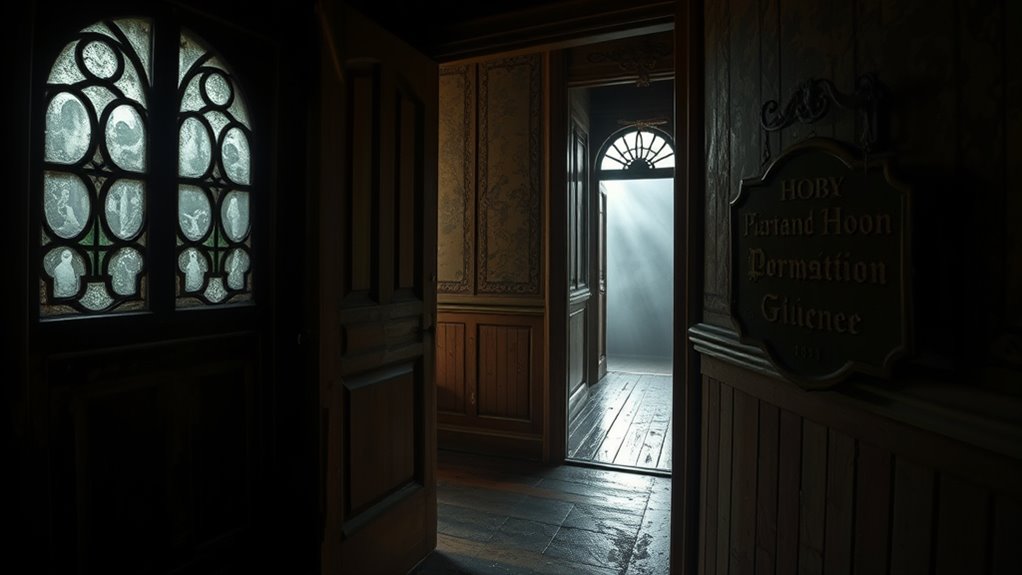
To understand the importance of the site, you need to begin by researching its history and context. This helps you grasp its historical context, revealing past events that shaped its current state. Understanding the cultural significance of the location allows you to appreciate its role in local traditions, beliefs, or stories, especially if it’s reputed to be haunted. Delving into these details provides insight into why the site matters, both historically and culturally. Exploring diverse designs of the site, such as architecture or layout, can also shed light on its historical use and significance, ensuring a more comprehensive understanding. Additionally, examining dog names associated with similar sites or stories can sometimes offer unique perspectives or inspiration for your exploration. Recognizing the importance of skilled craftsmanship in historical structures can deepen your appreciation for the site’s construction and purpose. This research forms the foundation for a meaningful and responsible exploration of the site. Familiarizing yourself with paint sprayers and their proper use can also inform how you prepare and protect yourself during exploration, ensuring safety and efficiency. It is also beneficial to understand the juice extraction techniques used historically or in modern times to better appreciate the tools and methods involved during site investigations.
Identifying the Property Owner or Managing Authority
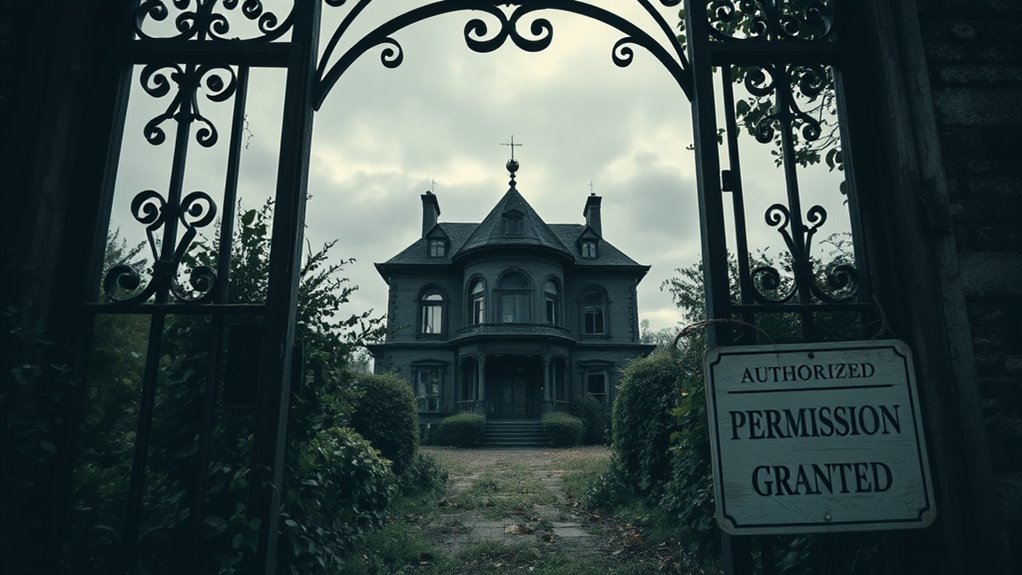
Understanding who owns or manages the site is a crucial first step before visiting. Identifying the property owner or managing authority helps you secure permission and avoid legal issues. To do this:
Knowing the owner or manager ensures proper access and legal, respectful visits.
- Check local property records or land registry databases for ownership details.
- Contact the property’s management or historical society for access permissions, especially if it has historical significance.
- Verify if the site has property insurance that covers visitation, as this can indicate legal ownership and responsibility.
- Recognize that property documentation can provide comprehensive information about ownership history and management. Additionally, understanding building and legal considerations for tiny houses can inform you about restrictions and requirements related to property use.
- Reviewing security zone info and associated safety measures can help you assess potential risks and plan appropriately. Incorporating AI security insights can further enhance your understanding of site vulnerabilities and security measures.
Knowing the owner ensures you follow proper channels and respect any restrictions, reducing risks of trespassing. Recognizing the property’s historical significance can also guide you in seeking permission from the right authorities, ensuring your visit is both respectful and lawful.
A thorough understanding of water safety protocols is also essential, especially when planning visits near water bodies or aquatic sites.
Understanding Legal Restrictions and Local Regulations
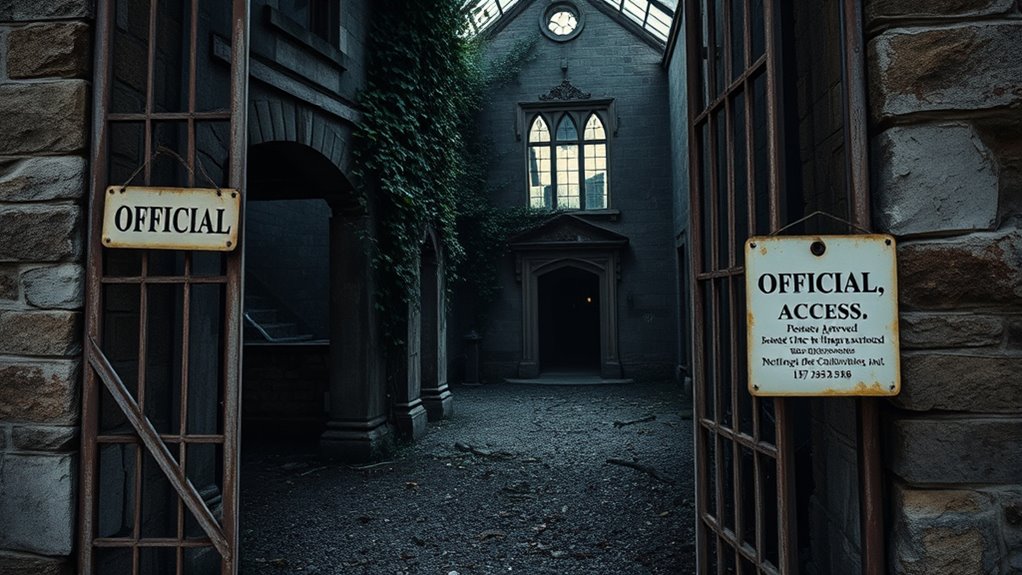
Before you proceed, understanding the permits and permissions required for your activity is crucial. Local laws and ordinances can vary greatly, so you need to stay informed about specific restrictions in your area. Ignoring these regulations could lead to fines or legal issues, so make sure to check them carefully. Additionally, staying updated on regulatory changes related to environmental and safety standards can help ensure your activities remain compliant. Incorporating home security system costs and considerations into your planning can also promote responsible engagement and raise awareness about preservation efforts. Being aware of the local regulations concerning the use of electric bikes and related equipment can further help you avoid potential legal complications. Awareness of environmental impact regulations can also guide responsible exploration and help protect protected sites.
Permits and Permissions
Securing the right permits and permissions is essential to guarantee your project complies with local laws and regulations. Understanding the historical significance and cultural context of a haunted location helps you justify your request and demonstrates respect for its importance. To navigate this process effectively, consider these steps:
- Research the property’s ownership and history to support your permit application.
- Contact local authorities to learn specific permit requirements related to cultural or historical sites.
- Obtain written approval from property owners or relevant agencies before starting your work.
- Familiarize yourself with retirement planning options that could be affected by project timelines or funding constraints.
Local Laws and Ordinances
Traveling through local laws and ordinances is essential to guarantee your project remains compliant with all legal restrictions. Understanding the historical context behind certain regulations helps you grasp why specific areas have strict rules about accessing haunted locations. Many laws are rooted in protecting historic sites or respecting local folklore associated with these sites. For example, some areas have bans on trespassing due to stories of spirits or legends that discourage unauthorized visits. Researching these regulations beforehand ensures you avoid legal trouble and show respect for the community’s traditions. Familiarizing yourself with local ordinances not only prevents violations but also demonstrates a responsible approach to exploring haunted locations, honoring their cultural significance and safeguarding your access for future investigations.
Crafting a Respectful and Clear Permission Request

When requesting permission, conveying clearly and respectfully is vital to increase your chances of a positive response. Your goal is to demonstrate sincerity, professionalism, and respect for the property and its history. To craft an effective request, consider these three tips:
- Clearly state your purpose—whether for paranormal investigations or ghostly encounters—highlighting your genuine interest and experience.
- Be polite and concise, explaining why access is important and how you plan to respect the location.
- Include any credentials or references to establish trust and credibility.
A respectful, transparent approach shows you value the property and its significance, helping you gain the permission needed to explore haunted locations responsibly and safely.
Establishing Contact and Building Rapport

Before making your formal request, taking the time to establish contact and build rapport can make all the difference. Share ghost stories or discuss local paranormal theories to create a common ground and show genuine interest. Listening carefully to their responses shows respect and builds trust, making it easier to ask for permission later. Approach with curiosity rather than skepticism, which demonstrates your respect for their experiences and beliefs. Mentioning shared interests in the supernatural helps break the ice and shows you’re not just there to investigate but to understand. Building rapport early on establishes a positive connection, making your request for access feel more natural and respectful. Remember, a good relationship opens doors that might otherwise stay closed.
Negotiating Terms and Conditions for Access
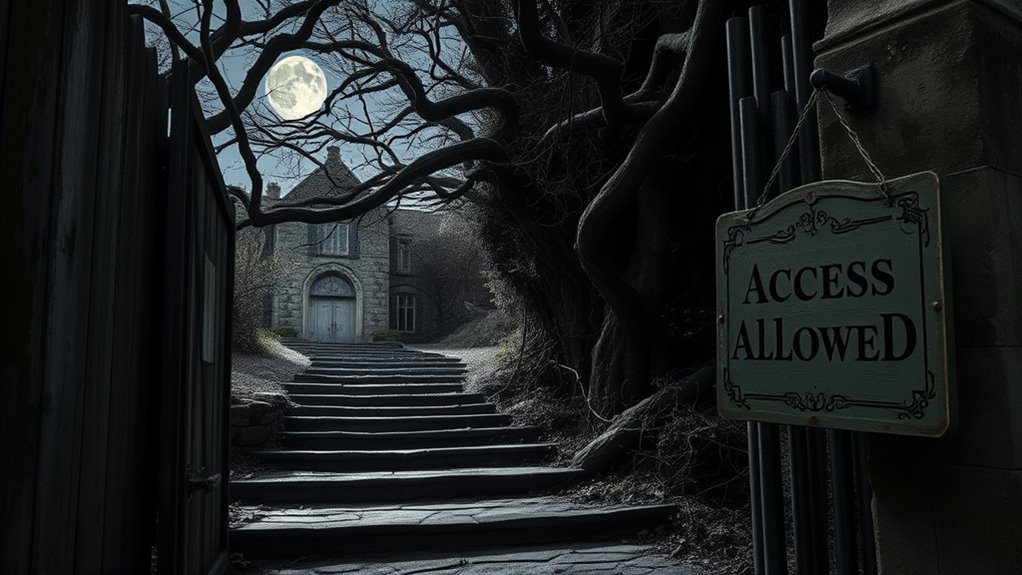
When negotiating access, you need to clearly understand permission requirements and set expectations upfront. Establishing a solid access agreement helps protect both parties and keeps things transparent. Remember to respect property boundaries to maintain trust and avoid conflicts.
Clear Permission Requirements
Have you ever wondered how to guarantee access is granted smoothly and without misunderstandings? Clear permission requirements are essential to avoid complications, especially when exploring locations with ghostly encounters or conducting paranormal experiments. To assure everything runs smoothly, focus on these key points:
- Define specific access times and durations to prevent misunderstandings.
- Clarify what activities are permitted, including any restrictions related to ghostly encounters or sensitive areas.
- Obtain written consent detailing safety protocols and liability waivers.
Being precise in your negotiations helps build trust and prevents surprises. When permissions are clear, you can focus on your paranormal experiments without worry, ensuring respectful and lawful access to haunted locations. This clarity keeps your exploration safe and professional.
Establishing Access Agreements
Once permission requirements are clearly outlined, the next step is to negotiate the specific terms and conditions that will govern your access. Understanding the historical context of the location helps you approach negotiations with respect and awareness of its significance. Be mindful of cultural sensitivities that may influence what is acceptable during your visit. Clarify whether photography, recording, or physical interaction is permitted, and agree on any restrictions or safety protocols. Establishing clear boundaries and expectations ensures mutual understanding and prevents misunderstandings later. Document the agreed-upon terms in a formal agreement or written consent, which protects both parties. By negotiating thoughtfully and respecting the location’s history and cultural sensitivities, you lay a solid foundation for a respectful and successful exploration.
Respecting Property Boundaries
Negotiating clear boundaries is essential to guarantee respectful and responsible access to property. You must understand property boundaries to avoid trespassing laws and legal issues. When discussing access, clarify the specific areas you’re allowed to explore and respect any posted signs or fences. Doing so shows respect for the property owner’s rights and helps prevent misunderstandings. To ensure smooth negotiations, consider these steps:
- Confirm boundaries with the property owner or manager before visiting.
- Get written permission outlining the specific areas you’re permitted to explore.
- Respect any restrictions or conditions set to avoid accidental trespassing.
Securing Written Authorization and Permits
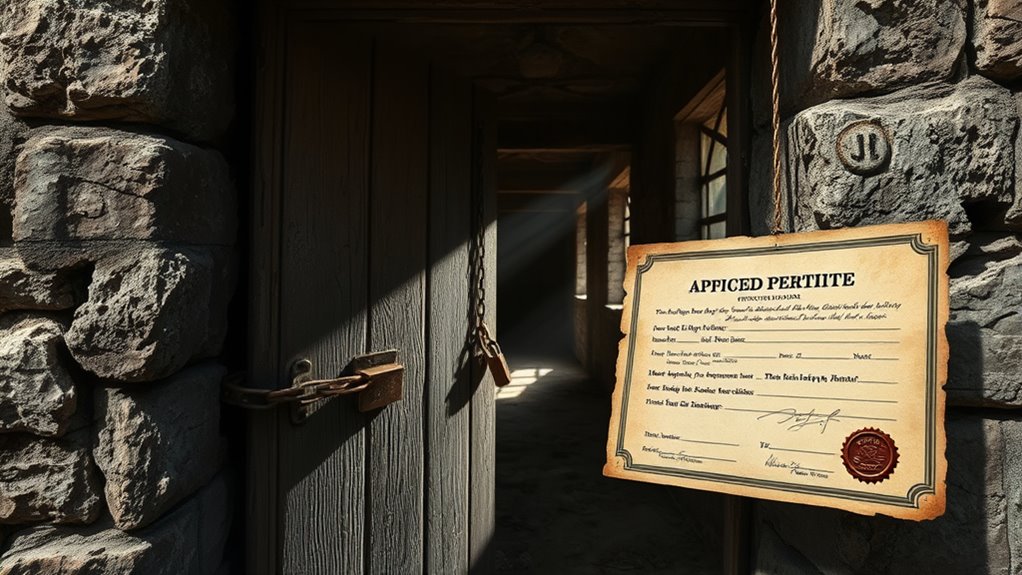
Securing written authorization and permits is a crucial step that guarantees your project complies with legal and regulatory requirements. Understanding the historical context helps you appreciate the property’s significance, while ethical considerations remind you to respect the site and its history. When approaching authorities, be prepared to provide detailed plans and proof of permission. To visualize this process, consider the table below:
| Step | Key Action | Purpose |
|---|---|---|
| Research | Identify property owner and regulations | Ensure legal access |
| Application | Submit permits and documentation | Formal approval |
| Follow-up | Confirm permission before entry | Avoid legal issues |
Securing proper authorization ensures respectful, lawful exploration, honoring both history and ethical standards.
Preparing for the Visit: Safety and Ethical Considerations

Before your visit, make certain you understand the necessary permissions and regulations to stay compliant. You’ll also want to gather the appropriate safety gear and follow precautions to protect yourself and others. Being prepared helps ensure your visit is both safe and ethically sound.
Research Permissions and Regulations
Understanding and adhering to research permissions and regulations is essential to guarantee your visit meets all safety and ethical standards. You need to respect the historical context of the location and be mindful of cultural sensitivities. This ensures your research is responsible and respectful.
To prepare effectively, consider these steps:
- Obtain necessary permits from local authorities or property owners before visiting.
- Research the historical background to understand its significance and avoid misrepresentation.
- Be aware of cultural sensitivities, especially if the site has spiritual or cultural importance, and approach with respect.
Following these guidelines helps you stay compliant and ethical, preserving the integrity of your investigation and honoring the site’s history and cultural significance.
Safety Gear and Precautions
Have you thought about the importance of proper safety gear and precautions before your visit? Wearing the right protective gear, like sturdy boots, gloves, and headlamps, keeps you safe in unpredictable environments. Follow safety protocols to avoid accidents or injuries during your exploration. Planning ahead ensures you’re prepared for hazards like unstable floors or debris. To help you understand the significance, here’s a quick overview:
| Safety Consideration | Purpose |
|---|---|
| Protective gear | Prevents injuries from sharp objects or falls |
| Clear pathways | Reduces trip hazards |
| Adequate lighting | Improves visibility, avoiding accidents |
| Communication tools | Keeps you connected in emergencies |
| Local guidelines | Ensures ethical and safe exploration |
Prioritize safety to enjoy your haunted location adventure responsibly.
Documenting the Process and Maintaining Records
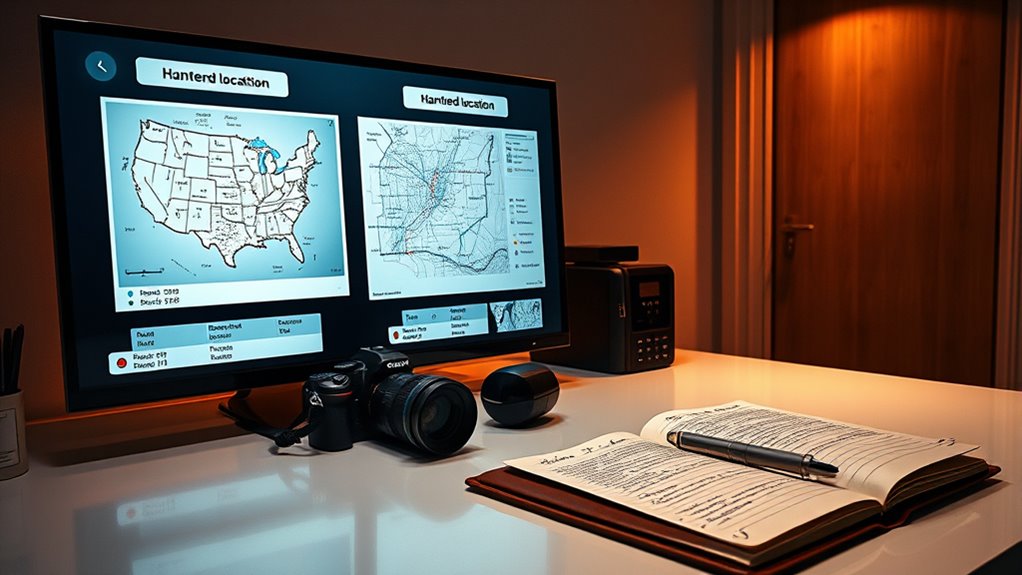
Documenting the process and maintaining records are essential steps to guarantee transparency and accountability in any project or operation. Your records serve as proof of compliance with permissions and help preserve the site’s history and cultural sensitivity. To stay organized, consider these key actions:
Keeping detailed records ensures transparency, accountability, and the preservation of cultural heritage.
- Keep detailed logs of your activities, including dates, times, and locations, emphasizing historical preservation efforts.
- Take photos and videos to document conditions before, during, and after your exploration, highlighting cultural sensitivity.
- Save all correspondence and permission documents securely for future reference or audits.
Respecting the Property During and After the Exploration
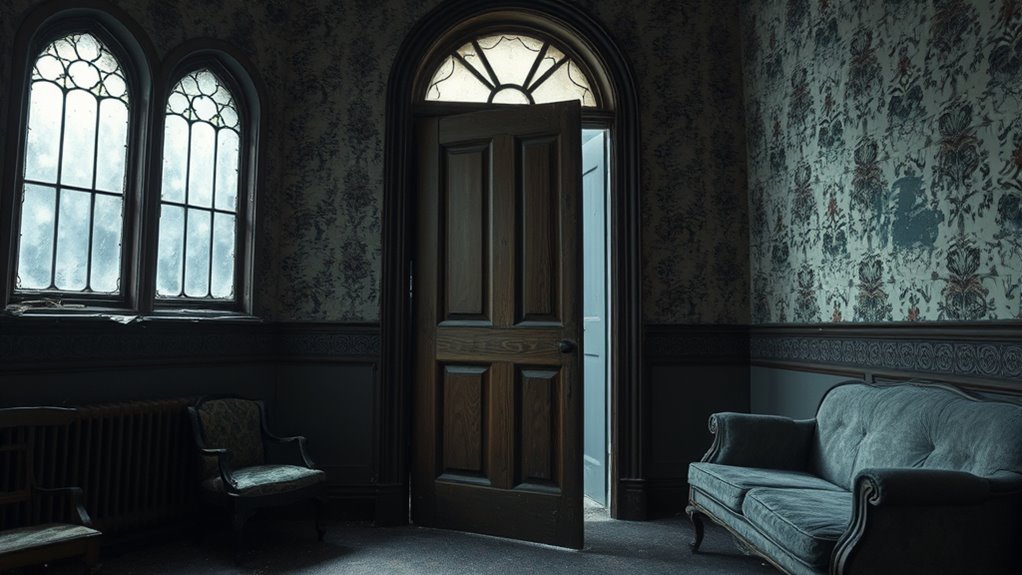
Respecting the property during and after your exploration shows your commitment to preserving the site’s integrity and honoring its significance. Maintain proper visitor conduct by staying on designated paths and avoiding unnecessary contact with delicate or restricted areas. Be mindful of property security; don’t leave trash or evidence of your visit behind. Leaving the site in good condition demonstrates respect for the property’s history and the owners’ wishes. If you notice any damage or issues, report them promptly to the appropriate authorities. Remember, your actions influence future explorers’ access and the site’s preservation. By acting responsibly, you help ensure that haunted locations remain protected and respected for years to come. Your respectful conduct is essential to maintaining the site’s authenticity and safety.
Frequently Asked Questions
How Long Does It Typically Take to Get Permission Approved?
Getting permission approved usually depends on your permit application and the documentation process. It can take anywhere from a few days to several weeks, depending on the location and the complexity of your request. You should submit a detailed permit application, include all necessary documentation, and follow up regularly. Being thorough and timely with your paperwork helps speed up approval, so plan ahead to avoid delays.
Can I Access Haunted Locations Without Official Authorization?
Venturing into haunted locations without official authorization is like chasing ghostly encounters in a shadowy fog—you risk stumbling into trouble. Without proper permission, you’re unlikely to partake in genuine paranormal investigations, as authorities protect these sites. Trying to access such places unofficially can lead to legal consequences and disrupt your chances of authentic experiences. For meaningful ghostly encounters, it’s best to follow protocols and secure the necessary permissions first.
What Are Common Reasons for Permission Denial?
You might be denied permission to visit haunted locations if concerns about safety or respecting private property arise. Authorities often cite risks of accidents during ghost encounters or potential damage to sites of historical significance. They want to prevent disturbances or unauthorized access that could harm the location’s integrity. Ultimately, permission is denied to protect both visitors and the site, especially when safety, preservation, or legal issues come into play.
Are There Age Restrictions for Permission Requests?
When it comes to age restrictions for permission requests, you need to be aware of age limits and consent requirements. Typically, minors require parental or guardian approval, guaranteeing they meet age limits for legal consent. You should check specific regulations for each haunted location, as rules vary—some may set strict age limits, while others require written consent from a parent or guardian to ensure compliance and safety.
How Should I Handle Rejected Permission Requests Professionally?
When your permission request gets rejected, you should handle it professionally by conducting a thorough risk assessment and reviewing legal considerations. Respect the decision and avoid pushing further unless new information emerges. Respond politely, ask if there’s a possibility to revisit the request later, and explore alternative options. Maintaining professionalism and understanding builds trust and keeps the door open for future opportunities.
Conclusion
Securing permission is like planting a sturdy seed in haunted ground—you nurture trust and respect from the start. With careful planning and clear communication, you cultivate a safe passage into the unknown. When you honor the rules and respect the space, you guarantee your journey through haunted locations blooms into a respectful exploration, not a reckless venture. Remember, your integrity keeps the haunted spirit of the site alive and respected for generations to come.









